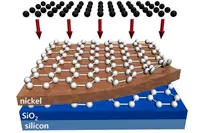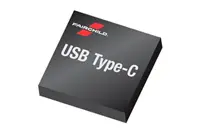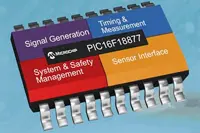Electronics News
Archive : 22 July 2015 год
 Researchers from Korea University say they have used an ion implantation technique to grow graphene on wafer scale silicon substrates.
Researchers from Korea University say they have used an ion implantation technique to grow graphene on wafer scale silicon substrates.
"For integrating graphene into advanced silicon microelectronics, large-area graphene free of wrinkles, tears and residues must be deposited on silicon wafers at low temperatures, which cannot be achieved with conventional graphene synthesis techniques," said Professor Jihyun Kim. "Our work shows the carbon ion implantation technique has great potential for the direct synthesis of wafer-scale graphene for integrated circuit technologies."
Although chemical vapour deposition is widely used for the large-area synthesis of graphene on copper and nickel films, this approach is not suited for silicon microelectronics, because temperatures in excess of 1000°C are needed and the graphene then has to be transferred to the silicon.
"The transferred graphene often contains cracks, wrinkles and contaminants," said Prof Kim. "Thus, we are motivated to develop a transfer-free method to directly synthesise high quality, multilayer graphene in silicon microelectronics."
In the new approach, carbon ions were accelerated onto a layered surface made of nickel, silicon dioxide and silicon at a temperature of 500°C, with the nickel layer used as a catalyst for graphene synthesis. The process was then followed by high temperature activation annealing to form a honeycomb lattice of carbon atoms.
According to Prof Kim, the ion implantation technique offers finer control on the final structure of the product than other fabrication methods, as the graphene layer thickness can be precisely determined by controlling the dose of carbon ion implantation.
"Our synthesis method is controllable and scalable, allowing us to obtain graphene as large as the size of a silicon wafer," Prof Kim said.
The next step for the team is to further lower the temperature in the synthesis process and to control the thickness of the graphene for manufacturing production.
Author
Graham Pitcher
Source: www.newelectronics.co.uk
 Texas Instruments has introduced two 32bit delta-sigma A/D converters that are said to combine high resolution, low noise and integrated fault detection. This combination, the company notes, eliminates many of the performance and features trade-offs typically associated with device evaluation and selection.
Texas Instruments has introduced two 32bit delta-sigma A/D converters that are said to combine high resolution, low noise and integrated fault detection. This combination, the company notes, eliminates many of the performance and features trade-offs typically associated with device evaluation and selection.
The ADS1262 and ADS1263, which feature a fast data rate and wide temperature range, have been developed in order to help to maximise the performance of programmable logic controllers (PLCs), industrial automation equipment and sensor measurement applications.
Noting the parts had been developed in association with a 'major PLC manufacturer', Bryan Lizon, from TI's precision data converter product marketing group, said: "High end applications, like test and measurement, are moving beyond 24bit, so there is the need more bits to give better accuracy. Meanwhile, there is also the need for greater system reliability. Industry 4.0 needs more reliability and not just the system – it means every part in the system."
Both parts enable accurate measurement of small signals, with a noise level of 7nVrms at 2.5sample/s suiting bridge applications where full-scale signals are typically less than 10mV. Offset error drift is also claimed to be 80% less than competitive solutions.
The ADS1262's features include a PGA, a 2.5V reference, a level shifter and dual excitation current sources. The ADS1263 adds an auxiliary 24bit delta-sigma A/D converter for use in those systems needing parallel main channel conversions, sensor-temperature compensation or sensor diagnostics.
With a maximum output data rate of 38ksample/s, the parts are specified for use in temperatures ranging from -40 to 125°C. A range of design tools is available to support the parts.
Author
Graham Pitcher
Source: www.newelectronics.co.uk
 Fairchild has launched a portfolio of USB Type-C solutions that enable manufacturers to add the next generation of USB functionality to smartphones, computers, power adapters and other devices. Fairchild's USB Type-C solutions are claimed to help manufacturers develop thinner, sleeker devices that consume less system power for better energy efficiency.
Fairchild has launched a portfolio of USB Type-C solutions that enable manufacturers to add the next generation of USB functionality to smartphones, computers, power adapters and other devices. Fairchild's USB Type-C solutions are claimed to help manufacturers develop thinner, sleeker devices that consume less system power for better energy efficiency.
"Relative to competing solutions that can consume up to 10x more power, Fairchild's USB Type-C solutions portfolio leads the industry in both low power consumption and small size, two critical requirements in today's increasingly small and thin battery-powered devices," said Jin Zhao, Sr. director, Product Line Business Management at Fairchild.
The USB Type-C devices feature small footprints.In particular, the FUSB302 comes in a 1.2 x 1.3mm WLCSP package to give manufacturers more flexibility in size constrained designs.
Several of Fairchild's USB Type-C solutions perform basic features such as detect attachment, orientation and device type, while others support more advanced functionality.These advanced functions include data role swap, power role swap, hard reset, soft reset, active cable support, Vendor Defined Messaging packet transmission and power charging up to 100W.
Author
Tom Austin-Morgan
Source: www.newelectronics.co.uk
 Microchip has announced two eight-bit families that expand its growing portfolio of PIC MCUs with Core-Independent Peripherals (CIPs). Eight-bit MCUs can be used in a broader range of applications, due to the growing number of these intelligent, interconnected CIPs that combine to perform functions autonomously, without the core.
Microchip has announced two eight-bit families that expand its growing portfolio of PIC MCUs with Core-Independent Peripherals (CIPs). Eight-bit MCUs can be used in a broader range of applications, due to the growing number of these intelligent, interconnected CIPs that combine to perform functions autonomously, without the core.
Because these functions are performed in hardware instead of software, CIPs enable system performance that is said to be far beyond typical eight-bit MCUs while simplifying the design and reducing memory cost.
The four members of the PIC16F1579 family are offered in 14 to 20-pin packages with up to 280KByte of Flash and feature CIPs that enable functions in applications such as LED lighting and motor control.
The 10 members of the PIC16F18877 family are available in 8 to 40-pin packages with up to 56KByte of Flash and feature CIPs for applications, such as consumer electronics, IoT and safety-critical systems.
Both families have an operating range of 1.8 to 5.5V, as well as featuring the Peripheral Pin Select feature, which enables flexible pin mapping and PCB routing to minimise EMI and crosstalk.
Author
Tom Austin-Morgan
Source: www.newelectronics.co.uk

